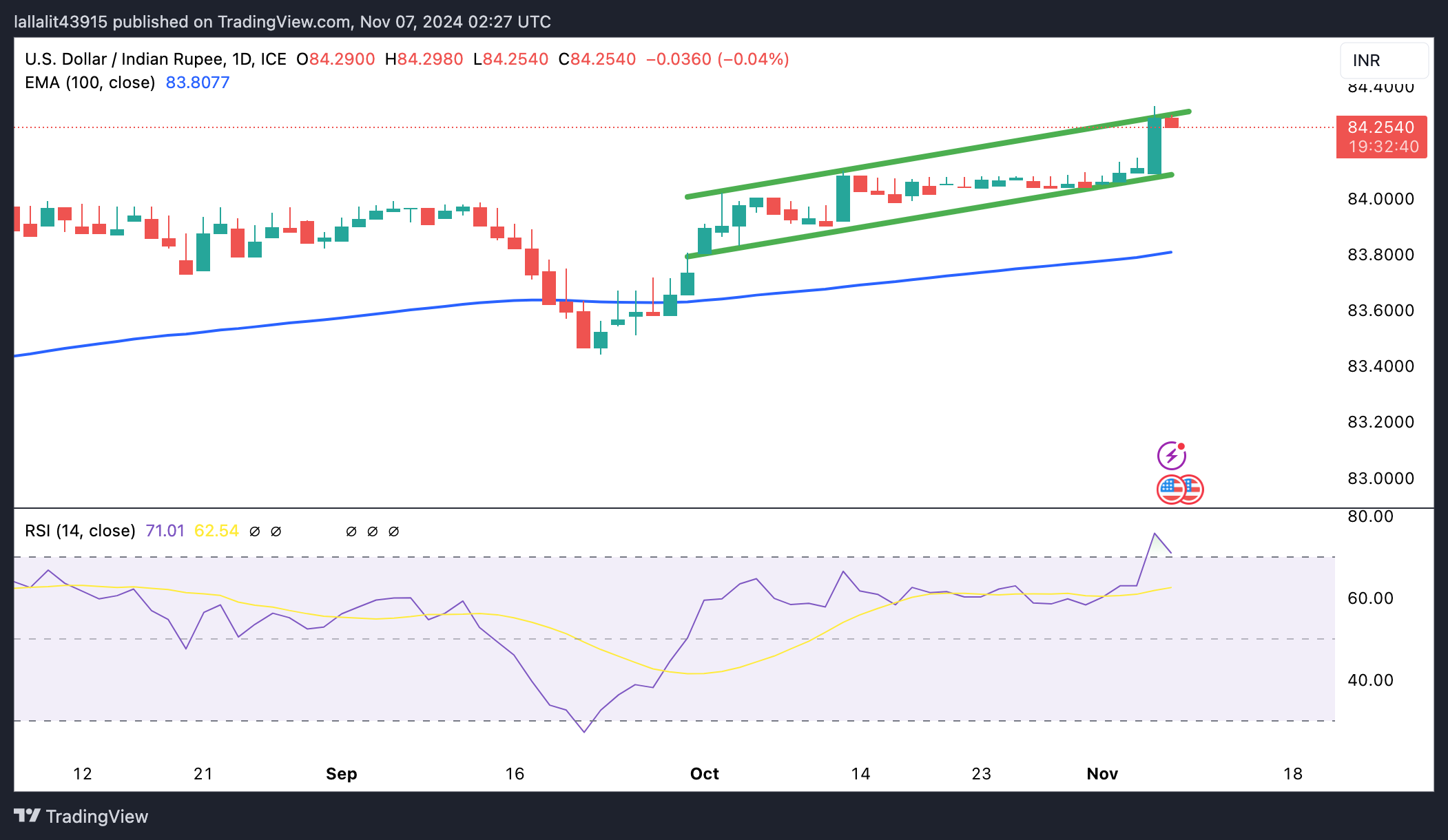Products You May Like
- The Indian Rupee trends lower in Friday’s early European session.
- The Indian equity selloff and the rise in crude oil prices continue to undermine the INR.
- The advanced US November Michigan Consumer Sentiment data and Fed Bowman’s speech will be the highlights on Friday.
The Indian Rupee (INR) weakens on Friday. The local currency depreciated to record lows again in the previous session amid weak domestic equities and sustained foreign fund outflows. Additionally, the rise in crude oil prices also weighed on the INR.
Donald Trump is expected to boost the US Dollar (USD) and push US yields higher, driven by anticipated populist measures that could increase borrowing, inflation, and yields. This, in turn, might contribute to the INR’s downside. However, the downward movement of the local currency might be limited as the Reserve Bank of India (RBI) is likely to intervene in the market by selling the USD to avoid excess volatility.
Looking ahead, traders will keep an eye on the advanced US Michigan Consumer Sentiment data for November. Also, the Federal Reserve’s (Fed) Michelle Bowman is scheduled to speak later on Friday.
Daily Digest Market Movers: Indian Rupee remains sensitive amid multiple headwinds
- Foreign investors have pulled out more than $1.5 billion from local stocks so far in November, adding to $11 billion of outflows in the previous month.
- India appears to be in a comparatively stronger position than many of its Asian peers, owing to its lower dependency on trade with China, according to a report by Emkay.
- The Federal Open Market Committee (FOMC) lowered its benchmark overnight borrowing rate by 25 basis points (bps) to a target range of 4.50%-4.75% at its November meeting on Thursday.
- Fed Chair Jerome Powell said the US central bank is pursuing interest rate cuts, while monetary policy remains tight. Powell further stated that the Fed will continue assessing data to determine the “pace and destination” of interest rates as inflation has slowed nearing the Fed’s 2% target.
- According to the CME FedWatch Tool, the possibility of a quarter-point December rate reduction rose to more than 68% following the Fed meeting, while the odds of a pause declined to nearly 32%.
- The US Initial Jobless Claims for the week ending October 25 increased to 221K, the US Department of Labor (DoL) showed Thursday. This figure matched initial estimates and was higher than the previous reading of 218K (revised from 216K).
Technical Analysis: USD/INR’s broader trends remain constructive
The Indian Rupee trades softer on the day. According to the daily chart, the USD/INR pair remains in a bullish trend as the price holds above the key 100-day Exponential Moving Average (EMA). Nonetheless, the 14-day Relative Strength Index (RSI) is over the midline near 75.0, suggesting an overbought condition. This means that additional consolidation should not be ruled out before positioning for any short-term USD/INR appreciation.
A move above the upper boundary of the ascending trend channel at 84.30 could pave the way for the next hurdle at 84.50, followed by the 85.00 psychological level.
On the other hand, a breach of the lower limit of the trend channel and the high of October 11 at the 84.05-84.10 region could draw in selling pressure to 83.82, the 100-day EMA. Further south, the next contention level is seen at 83.46, the low of September 24.
RBI FAQs
The role of the Reserve Bank of India (RBI), in its own words, is “..to maintain price stability while keeping in mind the objective of growth.” This involves maintaining the inflation rate at a stable 4% level primarily using the tool of interest rates. The RBI also maintains the exchange rate at a level that will not cause excess volatility and problems for exporters and importers, since India’s economy is heavily reliant on foreign trade, especially Oil.
The RBI formally meets at six bi-monthly meetings a year to discuss its monetary policy and, if necessary, adjust interest rates. When inflation is too high (above its 4% target), the RBI will normally raise interest rates to deter borrowing and spending, which can support the Rupee (INR). If inflation falls too far below target, the RBI might cut rates to encourage more lending, which can be negative for INR.
Due to the importance of trade to the economy, the Reserve Bank of India (RBI) actively intervenes in FX markets to maintain the exchange rate within a limited range. It does this to ensure Indian importers and exporters are not exposed to unnecessary currency risk during periods of FX volatility. The RBI buys and sells Rupees in the spot market at key levels, and uses derivatives to hedge its positions.

